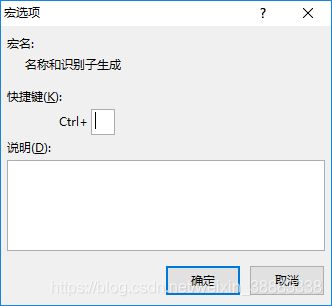VBA实现驼峰法变量名转换成下横杠式变量名
在excel中按ALT+F11打开VBA编辑器,选择插入模块
在模块中输入下面代码:
Sub 名称和识别子生成()
' 正规表示
Dim oRegExp As Object
Dim shtCount As Integer
If ActiveSheet.Cells(2, 1).Value <> "" Then
shtCount = ActiveSheet.Cells(1, 1).End(xlDown).Row
Dim i As Integer
For i = 2 To shtCount
Set oRegExp = CreateObject("vbscript.regexp")
oRegExp.Global = True
oRegExp.IgnoreCase = False
oRegExp.Pattern = "[^a-zA-Z0-9]"
ActiveSheet.Cells(i, 3).Value = Replace(oRegExp.Replace(ActiveSheet.Cells(i, 1).Value, ""), " ", "")
ActiveSheet.Cells(i, 4).Value = 识别子(ActiveSheet.Cells(i, 1).Value)
Next i
Set oRegExp = Nothing
MsgBox "名称和识别子生成成功!"
End If
End Sub
Sub 识别子生成名称()
Dim shtCount As Integer
If ActiveSheet.Cells(2, 1).Value <> "" Then
shtCount = ActiveSheet.Cells(1, 1).End(xlDown).Row
Dim j As Integer
For j = 2 To shtCount
Dim result As String
Dim strArray() As String
strArray = Split(ActiveSheet.Cells(j, 1).Value, "_")
Dim i As Integer
For i = 0 To UBound(strArray)
If i = 0 Then
result = strArray(i)
Else
result = result & UCase(Left(strArray(i), 1)) & Right(strArray(i), Len(strArray(i)) - 1)
End If
Next i
ActiveSheet.Cells(j, 3).Value = result
Next j
End If
MsgBox "识别子生成名称成功!"
End Sub
Function 识别子(str As String) As String
Dim tempString As String
If Trim(str) <> "" Then
Dim wordArray() As String
wordArray = Split(Trim(str), " ")
Dim j As Integer
For j = 0 To UBound(wordArray)
If wordArray(j) <> UCase(wordArray(j)) Then
Dim outWord As String
outWord = ""
Dim byteArray() As String
ReDim byteArray(1 To Len(wordArray(j)))
Dim i As Integer
For i = 1 To Len(wordArray(j))
byteArray(i) = Mid(wordArray(j), i, 1)
If byteArray(i) Like "[A-Z]" And i <> 1 Then
byteArray(i) = " " & LCase(byteArray(i))
Else
byteArray(i) = LCase(byteArray(i))
End If
outWord = outWord & byteArray(i)
Next i
wordArray(j) = outWord
Else
wordArray(j) = LCase(wordArray(j))
End If
tempString = tempString & wordArray(j) & " "
Next j
tempString = Left(tempString, Len(tempString) - 1)
' 正则表示
Dim oRegExp As Object
Set oRegExp = CreateObject("vbscript.regexp")
oRegExp.Global = True
oRegExp.IgnoreCase = False
oRegExp.Pattern = "[^a-zA-Z0-9 ]"
识别子 = LCase(Replace(oRegExp.Replace(tempString, ""), " ", "_"))
Set oRegExp = Nothing
End If
End Function然后,在EXCEL文件里按ALT+F8,会出现模块中的宏代码
点击执行就可以将图中名称转换,或是点击选项设置快捷键,以后按快捷键自动转换
输入q(小写q)则快捷键就是CTRL+Q
输入Q(大写Q)则快捷键就是CTRL+SHIFT+Q
也可以插入形状,然后右键选择指定宏也可


